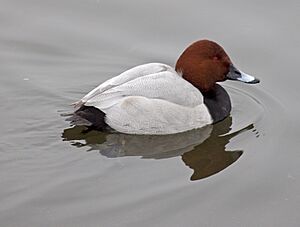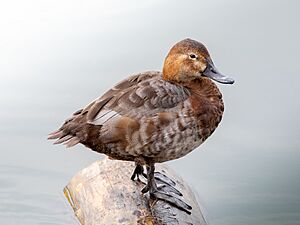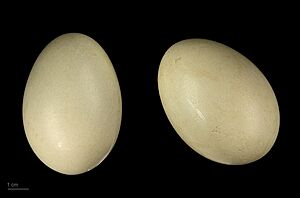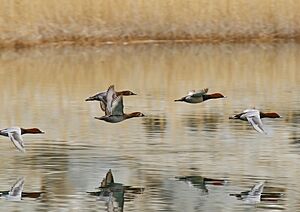Common pochard facts for kids
Quick facts for kids Common pochard |
|
|---|---|
 |
|
| Male | |
 |
|
| Female | |
| Conservation status | |
| Scientific classification | |
| Genus: |
Aythya
|
| Species: |
ferina
|
 |
|
| Range of A. ferina Breeding Resident Non-breeding | |
| Synonyms | |
|
Anas ferina Linnaeus, 1758 |
|
The common pochard (/ˈpɒtʃərd/, Aythya ferina) is a type of medium-sized diving duck. In the United Kingdom, it's often just called a pochard. These ducks live across a large area called the Palearctic, which includes Europe and Asia.
They usually make their nests in the steppe regions of Scandinavia and Siberia. When winter comes, they fly south and west to warmer places.
Contents
What is a Common Pochard?
Naming the Pochard
A long time ago, in 1758, a Swedish scientist named Carl Linnaeus gave the common pochard its first scientific name. He called it Anas ferina. This was part of his famous book, Systema Naturae, which helped organize how we name animals.
Later, in 1822, a German zoologist named Friedrich Boie created a new group, or genus, just for diving ducks. He moved the common pochard into this new group, called Aythya. Even though some people kept using the old name for a while, Aythya is now the accepted genus for this duck.
The common pochard is considered a "superspecies" with the canvasback. This means they are very similar and might have come from a common ancestor. In the past, some thought the redhead duck from North America was a type of common pochard, but now we know the common pochard is "monotypic." This means it doesn't have any different types or subspecies.
Sometimes, common pochards have babies with other kinds of ducks, like the tufted duck or ferruginous duck. This is called "hybridizing." It has happened when ducks are kept by people, and similar mixed ducks have been seen in the wild too.
Where Did the Name Come From?
The name Aythya comes from an old Ancient Greek word, aithuia. This word was used for a kind of seabird, but we're not exactly sure which one. In modern Greek, it can mean both a duck and a small seabird called an auklet.
The second part of its scientific name, ferina, is a Latin word. It means "wild game," from the word ferus, meaning "wild." The common name "pochard" has been used since the mid-1500s, but nobody knows for sure where that name came from! You might also hear it called the "European pochard" or "Eurasian pochard."
How to Spot a Common Pochard
The common pochard is a plump, medium-sized diving duck. It measures about 42 to 49 centimeters (16.5 to 19 inches) long. Its wings can spread out about 72 to 82 centimeters (28 to 32 inches). These ducks are quite stocky and have a short tail. They also have a sloped forehead and a fairly long bill.
They usually weigh between 467 to 1240 grams (about 1 to 2.7 pounds). Male ducks are generally bigger and heavier than females. Like most ducks, males and females look different. This is called being "sexually dimorphic."
Males and Females
The male common pochard is quite striking. He has a reddish-brown head and neck. His chest and tail are black, and his body is a pale grey. This grey part has fine, wavy lines called "vermiculations." His bill is dark grey with a wide blue-grey band in the middle. His eyes, called the iris, are yellow-orange to red. They get even brighter during the breeding season.
The female's eyes are brown, sometimes a yellowish-brown. Young ducks have yellow-olive eyes, but they change to the adult color during their first winter. The legs and feet of both male and female ducks, and ducks of all ages, are grey.
What Do They Sound Like?
Male common pochards are usually quiet. They might make a soft whistling sound when they are trying to attract a mate. The female makes a soft growling sound, like "krrr," especially if she is startled and flies away.
Baby common pochards have a short call with two to four notes to stay in touch with their family. If they are scared, their calls are higher and faster than those of other ducklings their size.
Ducks That Look Similar
The male common pochard looks a lot like the male canvasback duck. However, the canvasback has a bill that is all dark. The common pochard is also similar to the redhead duck, but the redhead has yellow eyes and a greyer back.
Where Common Pochards Live
Common pochards like to breed in marshes and lakes that are at least a meter (about 3 feet) deep. They make their homes in many parts of temperate and northern Europe and across the Palearctic region.
These ducks are migratory. This means they fly to different places for different seasons. They spend their winters in the warmer southern and western parts of Europe.
In the British Isles, common pochards breed in eastern England and the lowlands of Scotland. Small numbers are also found in Northern Ireland, and their numbers are slowly growing there. They are seen sometimes in the Republic of Ireland, where their population might also be increasing. While not common, you can sometimes spot them in southern England, and small groups are seen on the River Thames. Many common pochards also spend the winter in Great Britain after flying from Russia and Scandinavia.
How Common Pochards Live
Common pochards are social birds. They gather in large groups during winter, often mixing with other kinds of diving ducks. They are also strong fliers. When they fly straight, flapping their wings, they can reach speeds of about 22 to 24 meters per second (about 49 to 54 miles per hour)!
What Do They Eat?
Common pochards eat plants, including seeds. They also enjoy small fish, snails and clams, and other small creatures that live in water. They mostly find their food by diving underwater to grab items from the bottom. However, they can also "upend" themselves, tipping their bodies forward to dabble for food on the water's surface. They do most of their eating at night.
Sometimes, common pochards feed near Bewick's and whooper swans. These swans stir up the mud at the bottom of the water to find food. This helps the pochards because they can easily pick up the food items that float away from where the swans are digging. Studies have shown that this can double the amount of food a pochard gets compared to feeding alone!
Making a Family
The female common pochard builds a platform nest out of plants. It has a shallow dip in the middle, lined with soft down feathers. She places her nest either on the ground, within 10 meters (about 33 feet) of the water's edge, or right in the water, with the nest rising above the surface. The nest is always hidden in thick plants.
The female lays one egg each day until her "clutch" (a group of eggs) is complete. This is usually 8 to 10 eggs. Only after all the eggs are laid does she start to sit on them to keep them warm. This is called "incubation." The eggs are greenish-grey and broadly oval, measuring about 62 by 44 millimeters (2.4 by 1.7 inches) on average.
Like many ducks, common pochards sometimes have other ducks lay eggs in their nests. This is called "egg dumping." Studies have shown that in some areas, as many as 89% of nests have at least one egg that wasn't laid by the mother duck sitting on the nest. Sometimes, up to 37% of all eggs in a group can be from other ducks!
The mother duck usually doesn't mind these extra eggs. She will even roll any egg left near her nest into her clutch. However, if there are more than six extra eggs, she is twice as likely to leave her nest. Females sometimes lay their eggs in the nests of other duck species too, like red-crested pochards.
Many things can cause nests to fail, especially those on land. Nests on islands or over water (on special platforms) do much better. This is probably because the water helps keep away some mammal predators. How successful a nest is depends on things like the age of the female, how heavy she is, when she started the nest, and how many eggs she laid. Older, heavier ducks are more successful. Smaller clutches laid earlier are also less likely to be abandoned.
Protecting Common Pochards
The common pochard is a species that is protected by an agreement called the Agreement on the Conservation of African-Eurasian Migratory Waterbirds (AEWA). The International Union for Conservation of Nature (IUCN) says the common pochard is a "vulnerable" animal. This means it's at risk of becoming endangered.
Even though there are many common pochards and they live in a huge area, their numbers are dropping quickly in some places. For example, in Europe, their population has gone down by about 30–49 percent in just 23 years. In many countries, their numbers are decreasing because cities are growing, their natural homes are changing, and too many are being hunted.
New animals brought into an area, like the American mink, have also caused big problems for some pochard groups. In Poland, for instance, one group of pochards saw a 92 percent drop in their numbers over 30 years after minks arrived. Other birds, like carrion crows and marsh harriers, also eat their eggs.
Another challenge for protecting these birds is that people in the countries where they live speak 75 different official languages. This makes it harder for scientists to share information and work together to help the ducks.
The common pochard can sometimes carry tiny living things called parasites inside its body. These parasites usually don't hurt the duck much, but sometimes they can cause problems for other animals or even humans if they get into the water.




